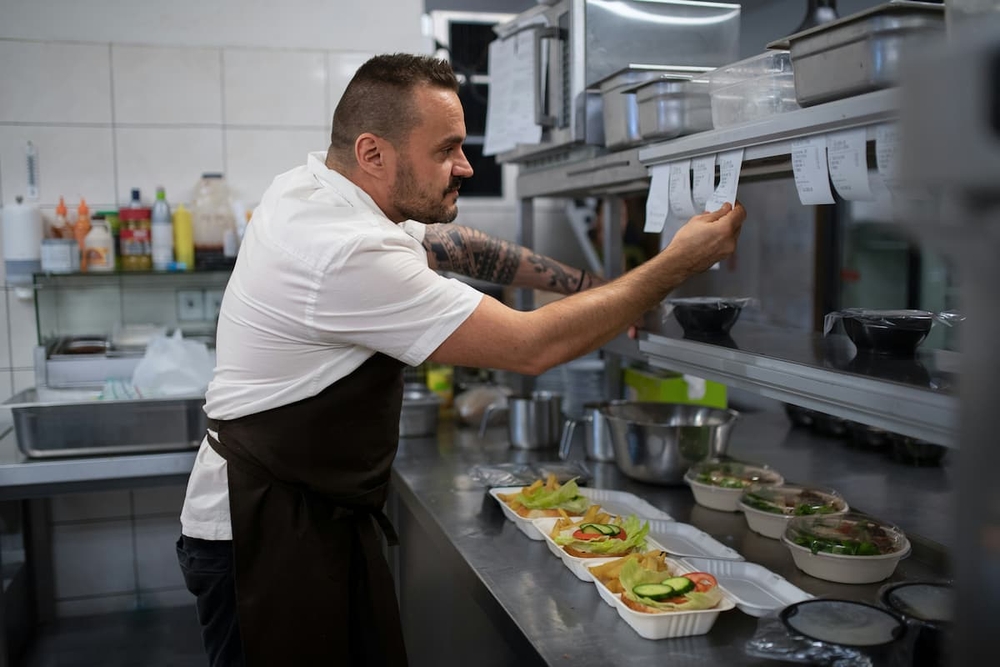Scaling up food production for growth and efficiency
Table of Contents
CloudKitchens
How many tacos can be delivered from a 1000sqft restaurant?
The same amount as a 200sqft ghost kitchen.
Scaling up food production is a crucial step for food businesses looking to expand their reach and improve efficiency. Whether you’re a restaurant, catering service, or have a ghost kitchen restaurant, increasing production capacity requires a strategic approach.
A production kitchen can be a game-changer in this process, offering a centralized and efficient facility designed for high-volume food production. In this article, we’ll explore the key aspects of scaling up food production, the role of a production kitchen, and best practices to ensure a smooth transition.
Understanding scaling in food production
Scaling up food production means increasing the volume of food prepared while maintaining consistency, quality, and efficiency. This process involves optimizing ingredients, refining workflows, and upgrading equipment.
Businesses that fail to plan properly risk operational inefficiencies, food waste, and inconsistent product quality.
The importance of scaling up production
- Meeting growing demand – As a food business gains popularity, the ability to handle increased orders without sacrificing quality becomes essential. Without proper scalability, businesses may struggle to keep up with demand, leading to longer wait times and dissatisfied customers.
- Cost efficiency – Scaling production often leads to lower ingredient costs per unit, reducing overall expenses. Bulk purchasing and optimized workflows can help cut costs while increasing profit margins.
- Consistency – Standardizing recipes and processes ensures uniformity in taste and presentation. Customers expect the same quality each time they order, so maintaining consistency is key to building brand trust.
- Expanding market reach – With higher production capacity, businesses can enter new markets, supply more locations, or offer delivery services. A well-structured production kitchen allows for geographic expansion without the need for multiple kitchen setups.
Read more: Essential guide to industrial kitchen equipment for ghost kitchens
How a production kitchen supports scaling up food production
A production kitchen is a specialized facility designed for large-scale food preparation. Unlike traditional restaurant kitchens, which must balance cooking and customer service, a production kitchen focuses solely on efficient food production. Here’s how it helps:
- Centralized food preparation – Having a single location for food prep streamlines logistics and reduces operational complexity, making it easier to manage production volume.
- Specialized equipment – Production kitchens come equipped with high-capacity ovens, mixers, and refrigeration systems tailored for bulk production. Investing in industrial-grade appliances ensures faster and more efficient cooking times.
- Improved workflow – These kitchens are designed for efficiency, ensuring seamless movement from prep to packaging. An optimized layout helps reduce unnecessary steps and maximizes space utilization.
- Food safety compliance – Dedicated facilities help maintain high hygiene standards, reducing the risk of contamination. Production kitchens follow strict food safety protocols to ensure compliance with health regulations.
- Cost savings – By focusing on bulk production, businesses can reduce labor and ingredient costs. Streamlined operations lead to better inventory control, minimizing waste and excess spending.
Read more: Kitchen Hygiene: rules and good practices to apply in your kitchen
Steps to scale up food production successfully
Scaling up food production requires careful planning, strategic investment, and a focus on efficiency. By following these key steps, food businesses can increase capacity, improve consistency, and meet growing customer demand without compromising quality.
1. Assess your current production capacity
Before scaling, evaluate your current kitchen’s limitations. Identify bottlenecks in food prep, storage, or distribution. This assessment will determine whether a production kitchen is necessary. Consider factors such as the efficiency of your current kitchen space, staff productivity, and supply chain management.
2. Streamline your menu and recipes
Simplify and standardize your menu to ensure consistent results. Removing low-performing items and optimizing ingredient usage can enhance efficiency. Consider how menu changes can impact overall production speed and customer satisfaction.
3. Invest in the right equipment
Scaling up requires commercial-grade appliances that can handle increased production. Consider:
- High-capacity ovens and stoves for faster cooking times;
- Industrial mixers and food processors for bulk ingredient preparation;
- Blast chillers for rapid cooling, preserving food freshness;
- Vacuum sealers for extended shelf life, reducing food waste.
4. Optimize your kitchen layout
An efficient layout minimizes movement and maximizes productivity. Key considerations include:
- Separate zones for prep, cooking, and packaging to reduce cross-contamination;
- Easy access to ingredients and equipment to improve workflow;
- Clear pathways to reduce congestion and ensure smooth operations.
Read more: Top 5 commercial kitchen layout ideas to maximize efficiency
5. Enhance inventory management
Invest in an inventory tracking system to monitor ingredient levels and reduce waste. Automated reordering can prevent shortages and overstocking. A well-maintained inventory system helps track expiration dates and minimize food spoilage.
6. Train your staff for efficiency
Scaling up requires a well-trained team. Provide training on:
- Batch cooking techniques to improve efficiency;
- Proper equipment operation to reduce maintenance costs;
- Food safety and handling protocols to maintain quality and compliance.
7. Integrate technology for better management
Cloud-based kitchen management software can streamline operations. Features like order tracking, inventory management, and automated scheduling improve efficiency. Leveraging digital solutions ensures better control over all aspects of food production.
8. Maintain food quality and consistency
As production increases, maintaining quality becomes a challenge. Regular quality checks, taste tests, and standard operating procedures (SOPs) ensure consistency. A focus on quality control prevents negative customer experiences and brand reputation damage.
9. Evaluate food safety regulations
Scaling up means more stringent compliance requirements. Ensure your production kitchen meets local health codes and food safety regulations. Conduct regular audits and inspections to identify potential risks.
10. Explore partnerships and outsourcing
If production demands exceed your capacity, consider partnerships with co-packers or third-party production facilities. Outsourcing allows businesses to scale quickly without heavy investment in infrastructure.
Read more: Kitchen Management Software: Why Consider?
The future of food production kitchens
With advancements in automation and AI-driven kitchen management, production kitchens are becoming more efficient. Key trends include:
- Automation and robotics – Automated cooking stations and robotic food prep enhance speed and precision, reducing labor costs.
- Smart inventory systems – AI-powered tracking systems predict ingredient needs and reduce waste, improving cost control.
- Sustainability initiatives – Eco-friendly packaging and energy-efficient appliances help reduce the environmental impact of high-volume production, meeting consumer demand for sustainable food practices.
- Cloud-based kitchen management – Digital tools help monitor food production in real-time, optimizing operations and improving efficiency.
- Alternative ingredients and lab-grown foods – The use of plant-based proteins and lab-grown meat is on the rise, catering to evolving consumer preferences.
- Personalized nutrition and meal customization – AI and data analytics are enabling food producers to create meals tailored to individual dietary needs and preferences.
- Blockchain for food safety and transparency – Blockchain technology is improving traceability, ensuring food safety, and enhancing consumer trust in ingredient sourcing.
Read more: Innovative restaurant technology trends
Scale your food business with CloudKitchens
Scaling up food production requires the right infrastructure, and a production kitchen can be the key to success. CloudKitchens offers state-of-the-art commercial kitchen spaces designed for efficiency, cost savings, and high-volume food production. Whether you’re a growing restaurant or a food delivery brand, our production kitchens can help you expand seamlessly.
Ready to take your food business to the next level? Explore CloudKitchens’ solutions today!
DISCLAIMER: This information is provided for general informational purposes only and the content does not constitute an endorsement. CloudKitchens does not warrant the accuracy or completeness of any information, text, images/graphics, links, or other content contained within the blog content. We recommend that you consult with financial, legal, and business professionals for advice specific to your situation.
More insights & stories
There’s more where that came from.
Get in the know and check out our additional insights


